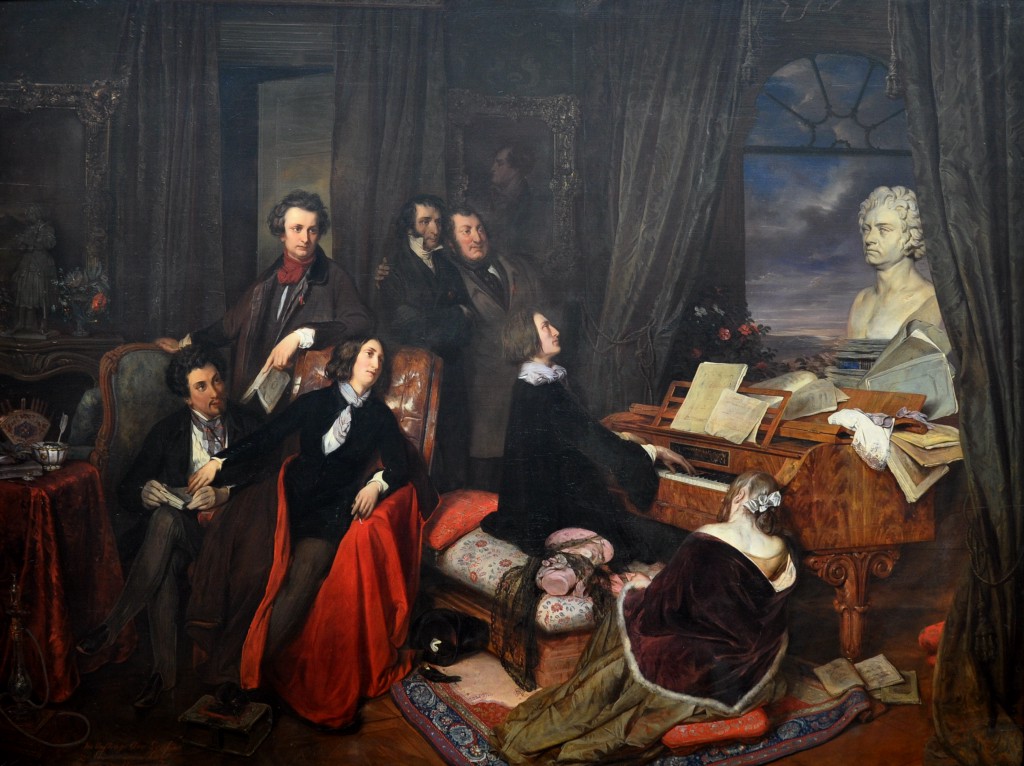Is Franz Liszt in Heaven or Hell? An Investigation

I never got the opportunity to play Franz Liszt in my years as a musician. My introduction to him came through literature — through one of my favorite books when I was in high school, Neil Gaiman and Terry Pratchett’s Good Omens. The book details a relationship between a slightly well-intentioned demon and a mischievous angel during what might be the apocalypse. The two are very into music, and early in the novel, they have the following exchange:
“We’ll win of course,” [Aziraphale, the angel] said.
“You don’t want that,” said the demon.
“Why not, pray?”
“Listen,” said [the demon] Crowley desperately. “How many musicians do you think your side have got, eh? First grade, I mean.”
Aziraphale looked taken aback. “Well, I should think — ” he began.
“Two,” said Crowley. “Elgar and Liszt. That’s all. We’ve got the rest. Beethoven, Brahms, all the Bachs, Mozart, the lot. Can you imagine eternity with Elgar?”
Aziraphale shut his eyes. “All too easily,” he groaned.
So Liszt is boring, I assumed. Virtuous. It’s insane that my teenage mind skipped right over the mention of Elgar, if only because at the time I was reading this book, one of my crushes was in the midst of learning one of the composer’s cello concertos. (We’ll get there in this column one of these days, when the wounds of my broken teenage heart have healed.) But this turned me off of Liszt for a good amount of time, and I continued not to ever play his works through no fault of my own.
I didn’t really encounter Liszt until I dove into Brahms this past winter. Liszt and Brahms had a deeply tumultuous relationship with each other, which was yet another minus on Liszt’s side for me. During the same time that Brahms was a young upstart composer, Liszt was sort of the godfather of the game. He collected allies in the scene, ranging from Berlioz to Saint-Saëns to Wagner. He had really perfected the symphonic poem, as well as embraced the responsibility and ownership over nationalistic music. Keep in mind, Liszt lived from 1811 to 1886, so this is a long time before composers like Dvořák or Janáček would embrace similar sensibilities.
Also Liszt was maybe an anti-Semite? Or at the very least, he at one point suggested that Semitic people have no “genuine creativity.” Lol uh? So maybe he doesn’t go to Heaven?
This week’s piece is his Hungarian Rhapsody №2 (recording done by Arthur Fielder of the Boston Pops, who you’ll remember as being 100% responsible for tormenting the ghost of Tchaikovsky). It’s widely used in pop culture. You may know it from the Marx brothers’ work or from “Looney Tunes” or “Animaniacs.” It plays an odd part in a bizarre Hungarian film called White God. It’s “around,” as they say.
What is Hungarian Rhapsody №2 precisely? Well, it was an orchestral adaptation of a piano piece that Liszt first composed in 1847, eventually publishing in 1851. And what is a rhapsody? Well, it’s a piece of music that takes on an indefinite form. So this is a very non-traditional sounding composition, even though it takes its roots in Hungarian folk music. It opens with a section called the lassan, a dark and stately theme. And dark and stately it is! I remember first hearing this piece and having this sort of sinking feeling. Thinking I knew exactly what it was going to be, and knowing, deep down, I didn’t want to bear the darkness of it. And yet, its opening refrain is not so unlistenable. It doesn’t turn you off, it just bears on you. That is, until, the clarinet cadenza around the 1:18 mark. There’s something playful there, something unknown. It’s a wink, no doubt, that something different is to come.
From there, the woodwinds take control for a bit. The piece pulls itself out of itself. Suddenly it livens up, starts to bounce a little. This is not the piece you thought it would be at its very beginning. Even when its opening theme reprises itself about 3 minutes in, there’s a buoyancy to it. Its stateliness was a facade.
And THEN! One of the absolute best things happens! You have no idea, but BAM, right at the 5:24 mark. Liszt lures you into a false ending, but no, he’s just changed directions. This, my friends, is the friska. It’s the fast part. And boy, it flipping races. It speeds up so arrogantly that you can’t help but respect the shit-eating grin nature of this type of escalation forward. Liszt has everyone going: the woodwinds, the strings, the low brass. And then when he hits the 6:04 mark, just when you think it’s going to race out of control, he brings out the crash cymbals and balances it back out again. Now we’re having fun, and you almost don’t care that he maybe hated Jews (just kidding — we DO care and it IS bad).
There are so many pleasant fucking touches in this second half. I love this part at the 6:59 mark where it occasionally sounds like the strings’ bows are just sliding all the way off of the instrument. Even the TRIANGLE is going insane. I’m not kidding at all. I wouldn’t joke about triangle. Listen to that part at 7:27. It’s just ringing and blaring as loudly as that little and occasionally awful instrument can go. This is not music composed by some boring heavenly rule-follower. It’s cocky! It’s disorienting! Liszt is not dull by any stretch of the imagination. There’s power and seductiveness to his writing, and it almost makes you think that maybe, just maybe, he’s in Hell with the rest of the good composers.
Fran Hoepfner is a writer from Chicago. You can find a corresponding playlist for all of the pieces discussed in this column here.
